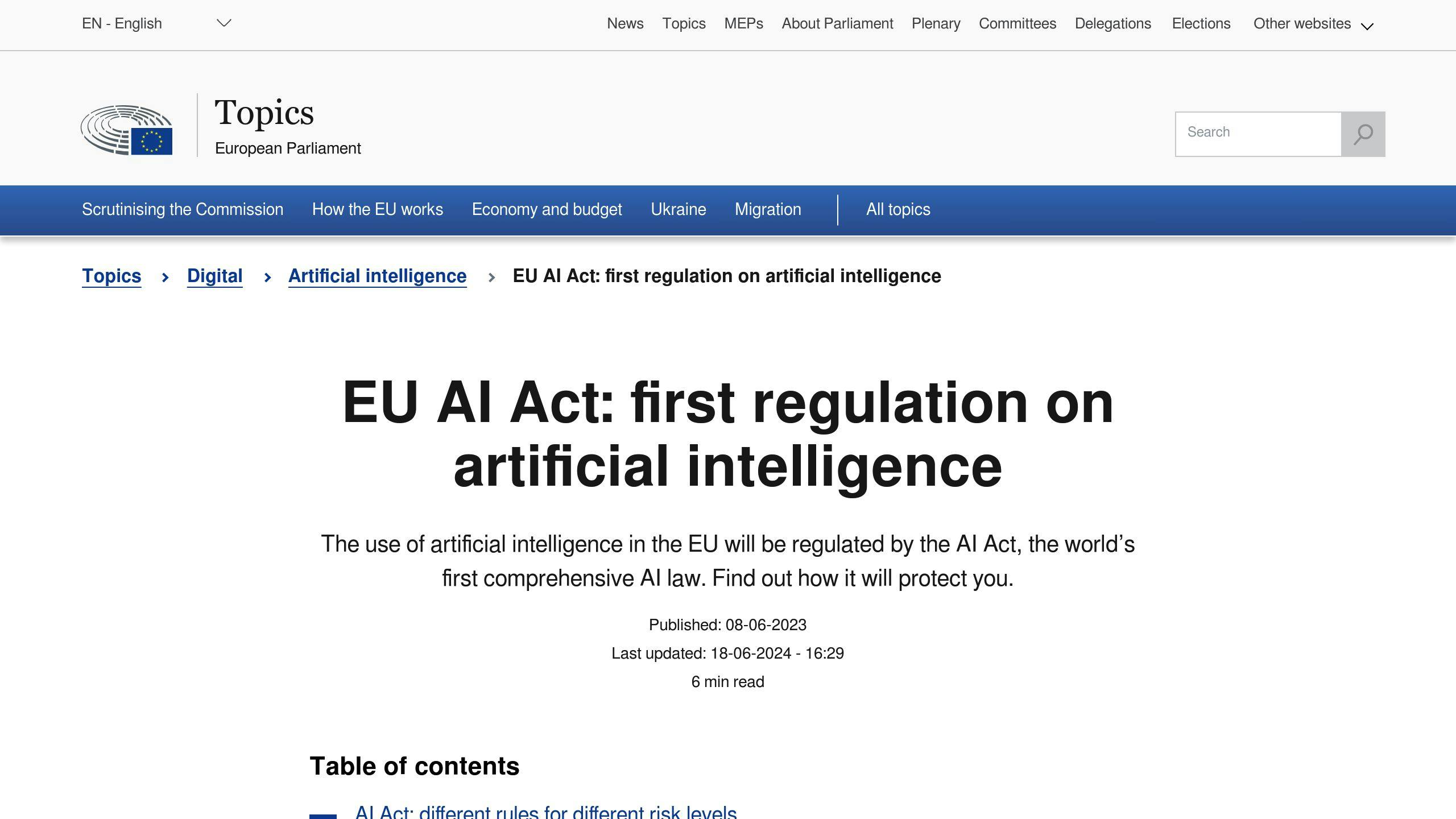The EU AI Act, effective August 1, 2024, introduces strict rules for AI systems, classifying them into four risk levels: unacceptable, high-risk, limited-risk, and minimal-risk. High-risk AI, like systems for hiring or credit scoring, faces the most stringent requirements, including risk assessments, documentation, and human oversight. Non-compliance can result in fines up to €35 million or 7% of global turnover.
Key Compliance Steps:
- Audit AI Systems: Identify risks, gaps, and compliance needs.
- Set Up Governance: Form a team with legal, IT, and data experts.
- Automate Monitoring: Use tools like Eyer.ai for real-time risk detection, automated documentation, and oversight.
Why It Matters:
Complying with the Act builds trust, avoids penalties, and positions businesses as leaders in ethical AI. Tools like Eyer.ai simplify compliance by automating key processes, reducing costs, and ensuring regulatory alignment.
| Risk Level | Examples | Key Rules |
|---|---|---|
| Unacceptable | Social scoring | Banned |
| High-Risk | Hiring, credit scoring | Risk assessments, oversight |
| Limited-Risk | AI-generated content | Transparency, clear labeling |
| Minimal-Risk | Basic AI tools | Basic transparency |
Quick Tip:
Start compliance efforts early to meet deadlines (6-24 months) and reduce risks. Tools like Eyer.ai help streamline the process, offering automated solutions tailored to the EU AI Act’s requirements.
Breaking Down the EU AI Act: Rules and Challenges

How the EU Classifies AI Risks
The EU AI Act organizes AI systems into different risk levels, each with specific rules businesses must follow. Here's a quick overview:
| Risk Level | Description | Key Requirements |
|---|---|---|
| Unacceptable | AI systems that threaten fundamental rights | Completely banned |
| High-Risk | Systems in areas like critical infrastructure, hiring, or credit scoring | Conformity checks, database registration, human oversight |
| Limited-Risk | Systems requiring transparency, like AI-generated content | Clear labeling |
| Minimal-Risk | Basic AI tools with little impact | Basic transparency |
Challenges Businesses Face
Complying with the EU AI Act isn't straightforward. Businesses encounter several obstacles, including:
- Risk Assessment Complexity: Determining which risk category an AI system belongs to requires detailed technical knowledge and a thorough evaluation of its impact on fundamental rights.
- Technical Barriers: Ensuring transparency in AI decision-making, especially with intricate machine learning models, can be daunting.
- Tight Deadlines: Depending on the risk level, companies have just 6 to 24 months to implement measures like conformity assessments and database registration.
- Ongoing Monitoring: Real-time monitoring of AI systems, such as those used in hiring, is necessary to detect and address unintended biases.
- Financial Strain: Compliance demands substantial investments in tools, processes, and expert resources.
Key Rules for Compliance
High-risk AI systems face the strictest rules under the Act. These include:
- Data Governance: Strong controls are required to avoid bias in high-risk systems.
- Documentation and Oversight: Providers must maintain detailed records of system development and ensure human oversight to reduce risks to fundamental rights.
- Monitoring Systems: Postmarket monitoring is essential to track performance and address any issues that arise.
To navigate these challenges, tools like Eyer.ai are proving invaluable, helping businesses streamline compliance efforts and minimize risks.
Related video from YouTube
Using Tools to Meet AI Compliance Standards
Tools like Eyer.ai play a key role in helping businesses navigate the EU AI Act by offering solutions for monitoring, detecting, and addressing compliance challenges.
How Eyer.ai Supports Compliance

Eyer.ai provides businesses with tools designed to meet the EU AI Act's requirements. These include real-time monitoring, automated documentation, and support for human oversight.
1. Real-Time Risk Detection
Eyer.ai’s anomaly detection system keeps a constant watch on AI operations. It flags issues like biases, unauthorized changes, data quality problems, and performance dips, allowing companies to address risks before they escalate.
2. Automated Documentation and Record-Keeping
The platform simplifies compliance by automating documentation. It generates detailed records of AI system operations, including risk assessments and corrective measures, cutting down on manual work while ensuring precision.
3. Human Oversight Support
Eyer.ai’s dashboard delivers actionable insights in real time, making it easier for team members to oversee operations. Its user-friendly design ensures that human intervention is both effective and aligned with compliance standards.
AI Compliance Tools Comparison
While Eyer.ai offers a strong suite of compliance features, other tools can enhance its capabilities by focusing on specific aspects of the EU AI Act:
| Tool | Primary Focus | Key Features |
|---|---|---|
| Eyer.ai | AI Compliance Monitoring | Compliance monitoring, automated documentation, real-time detection |
| Datadog | General IT Monitoring | Performance tracking, broad ecosystem integration |
| Diligent's AI Act Toolkit | Risk Assessment | Pre-built templates, automated risk scoring |
| Microsoft Azure AI Guardian | Security & Governance | Built-in compliance controls, data protection |
Key Differentiators: Eyer.ai vs. Datadog
| Feature | Eyer.ai | Datadog |
|---|---|---|
| AI Compliance Focus | Tailored for AI compliance | General IT monitoring with AI features |
| Real-time Monitoring | AI-specific anomaly detection | General performance tracking |
| Documentation Support | Automated compliance documentation | Manual documentation required |
sbb-itb-9890dba
Steps to Achieve Compliance with AI Tools
Audit Your AI Systems
To ensure your AI systems meet regulatory standards, start with a thorough audit. This process covers three key areas:
1. System Documentation
- Include technical details about system specifications.
- Classify risks based on EU AI Act criteria.
- Assess the system's current compliance status.
2. Compliance Gap Analysis
- Compare current operations with EU AI Act requirements.
- Identify and prioritize necessary updates.
- Plan resource allocation to address these gaps.
3. Risk Assessment
Use automated tools to pinpoint potential issues, such as:
- Data quality concerns
- Algorithmic bias
- Security weaknesses
- Performance inconsistencies
Create a Team for AI Governance
Building a governance team is essential for managing compliance. This team should bring together experts from different departments:
| Role | Responsibility | Key Focus Areas |
|---|---|---|
| Legal Expert | Regulatory compliance | EU AI Act interpretation, tracking updates |
| IT Manager | Technical implementation | System security, architecture |
| Business Analyst | Impact assessment | Aligning processes, managing risks |
| Data Scientist | Model oversight | Checking algorithms, spotting biases |
The team should meet regularly to:
- Review compliance reports generated by monitoring tools.
- Evaluate new AI systems for regulatory alignment.
- Update procedures as regulations change.
- Handle compliance-related issues efficiently.
Once the governance team is established, the next phase is to automate compliance processes for better efficiency.
Automate Compliance Monitoring
With governance structures in place, automation can streamline compliance efforts. Tools like Eyer.ai provide centralized dashboards to monitor compliance metrics and create real-time reports.
Under Article 19 of the EU AI Act, detailed logging and documentation are mandatory for high-risk AI systems. Accurate records are crucial and should include:
- System operation logs
- Results from risk assessments
- Details of corrective actions taken
- Ongoing performance data
"Providers of high-risk AI systems must keep logs automatically generated by their systems. These logs should enable effective post-market monitoring and be available to authorities upon request", states Article 19 of the EU AI Act.
Conclusion: Turning Compliance into a Business Strength
Key Takeaways
To meet the EU AI Act’s requirements, businesses should focus on three main areas: risk management, monitoring systems, and documentation. High-risk AI systems need thorough evaluations, while tools like Eyer.ai provide continuous monitoring to maintain compliance. Automated documentation tools simplify reporting processes, making it easier to meet specific regulatory needs. Risk classification determines the level of compliance required, and automated solutions make monitoring and documentation more efficient - especially for high-risk systems.
Compliance isn’t just about following rules - it can also improve business operations and reputation.
Why Compliance Matters for Business Success
Strong compliance practices build trust with stakeholders. Oversight from the European AI Office adds credibility to AI systems that meet regulations, giving businesses an edge in the market. Tools like Eyer.ai help reduce oversight costs, simplify audits, and avoid penalties. Adopting these measures early during the EU AI Act rollout can position companies as leaders in ethical AI development.
| Compliance Focus Area | Business Benefit |
|---|---|
| Automated Monitoring | Cuts manual oversight costs and identifies risks early |
| Documentation Systems | Simplifies audits and lowers the chance of regulatory issues |
| Governance Framework | Speeds up decision-making and reduces compliance delays |
Investing in compliance can fuel growth by boosting trust, reducing risks, and standing out in the market. Platforms like Eyer.ai show a company’s dedication to responsible AI, giving them a competitive edge in Europe and beyond.
FAQs
What are the logging requirements for the EU AI Act?
Logging plays a crucial role in ensuring transparency, supporting audits, and responding quickly to incidents. Under the EU AI Act, providers of high-risk AI systems must maintain detailed, automatically generated logs to identify and resolve issues effectively.
Here’s a breakdown of the key logging requirements:
| Logging Requirement | Duration | Purpose |
|---|---|---|
| Standard Documentation | Minimum 6 months | Identify and fix issues |
| Personal Data Related | Extended period | Align with EU/national data protection laws |
| Incident Reports | 15 days deadline | Notify authorities of serious incidents promptly |
These rules focus on keeping records that are both thorough and easy to access, ensuring compliance with regulations.
How does risk classification affect compliance?
Risk classification directly impacts the level of compliance required. High-risk systems face stricter rules, including more detailed logging and reporting obligations. Understanding the classification helps allocate resources more effectively.
What should the logs include?
For high-risk AI systems, logs must capture:
- System Operations: Details of AI activities and decisions
- Performance Metrics: Information on accuracy, reliability, and bias
- Security Events: Cybersecurity incidents and access attempts
- Corrective Actions: Steps taken to address and resolve issues
"Providers must report serious incidents related to high-risk AI systems to the market surveillance authorities of the Member State or States where the incident happened, no later than 15 days after becoming aware of it."
This reporting requirement ensures transparency, helps address issues swiftly, and aligns with the broader regulatory framework.



